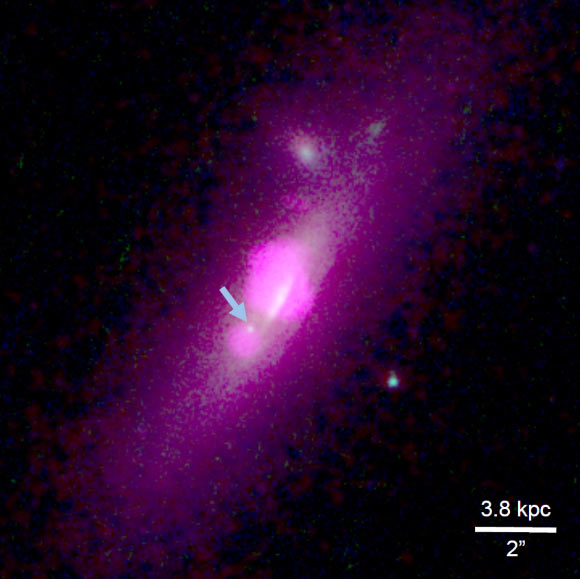A team of astronomers led by Dr Julia Comerford of the University of Colorado, Boulder, has spotted a rare pair of black holes in a distant galaxy known as J1126+2944.

This composite image from the NASA/ESA Hubble Space Telescope and NASA’s Chandra X-ray Observatory shows the galaxy SDSS J112659.54+294442.8. The arrow points to the black hole that lost most of its stars due to gravitational stripping processes. Image credit: NASA / ESA / Hubble Team / Chandra Team / Julia M. Comerford et al.
J1126+2944 (SDSS J112659.54+294442.8) is a galaxy located in the constellation Ursa Major, approximately 1.3 billion light-years away.
According to Dr Comerford and her colleagues, this galaxy is the result of a merger between two smaller galaxies, which brought together a pair of black holes.
One of the black holes is surrounded by a typical amount of stars, but the other black hole is strangely ‘naked’ and has a much lower number of associated stars than expected.
“One black hole is starved of stars, and has 500 times fewer stars associated with it than the other black hole. The question is why there’s such a discrepancy,” said Dr Comerford, who is the first author of a paper published in the Astrophysical Journal (arXiv.org preprint).
“One possibility is that extreme gravitational and tidal forces simply stripped away most of the stars from one of the black holes over the course of the galactic merger.”
“The other possibility, however, is that the merger actually reveals a rare intermediate mass black hole, with a mass of between 100 and 1 million times that of the Sun.”
Intermediate mass black holes are predicted to exist at the centers of dwarf galaxies and thus have a lower number of associated stars. These intermediate mass black holes can grow and one day become supermassive black holes.
“Theory predicts that intermediate black holes should exist, but they are difficult to pinpoint because we don’t know exactly where to look. This unusual galaxy may provide a rare glimpse of one of these intermediate mass black holes,” explained co-author Dr Scott Barrows, also of the University of Colorado, Boulder.
If J1126+2944 does indeed contain an intermediate black hole, it would provide astronomers with an opportunity to test the theory that supermassive black holes evolve from these lower-mass ‘seed’ black holes.
_____
Julia M. Comerford et al. 2015. Merger-driven Fueling of Active Galactic Nuclei: Six Dual and Offset Active Galactic Nuclei Discovered with Chandra and Hubble Space Telescope Observations. ApJ 806, 219; doi: 10.1088/0004-637X/806/2/219







